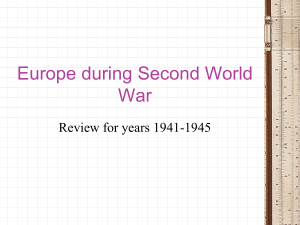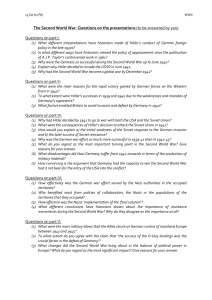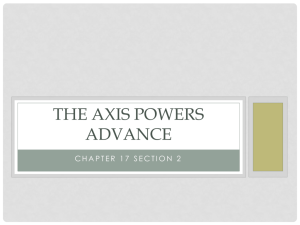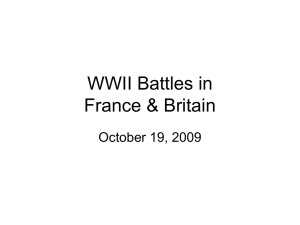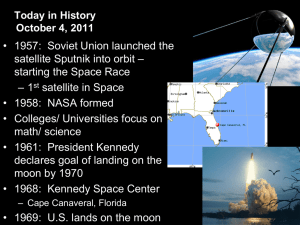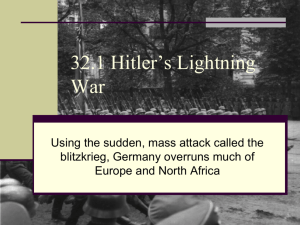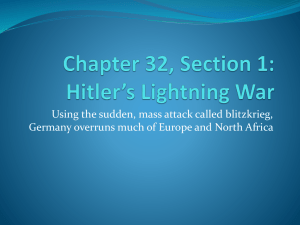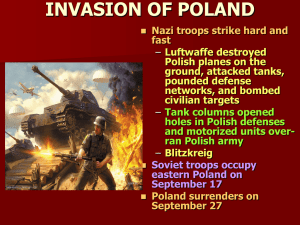2 World War II notes study guide
advertisement
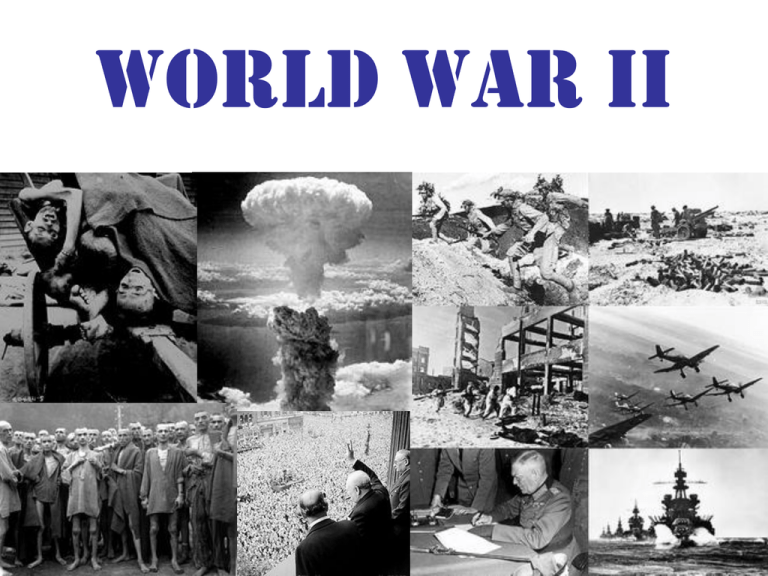
World War II 1. Europe and Asia Post-WWI • • • • Economic depression and social problems Deep feelings of nationalism Strong desire to expand & gain territory Rise of dictators: democratic govt fails & people turn to authoritarians to fix the problems • The Allies blamed Germany for the war & punished them harshly anger and resentment on all sides – Germany lost their colonies & territories – Soviets lost parts of Russia A. Joseph Stalin: Man of Steel • Goal: worldwide spread of communism • Great Purge: 8-13 million executed or banished to Siberia • Totalitarian: total control over citizens B. Benito Mussolini • Fascism: strong central govt • Nationalist/patriotic • Invades Ethiopia, 1935 – Ethiopians had defeated Italians in 1896, so Mussolini wanted revenge – League of Nations issues sanctions – no real consequences C. Adolf Hitler • Nazism: extreme racism, expansionism and nationalism, Hitler's book Mein Kampf • Aryans: the master race that needs to be served by inferior races D. Emperor Hirohito and P. M. Tojo • Japan needs more living space • Japan attacks & conquers Manchuria in 1931 (wants their natural resources) • League of Nations issues sanctions against Japan Japan quits • Later invades Eastern China in 1937 Japanese Acquisitions, 1937 E. Appeasement & Neutrality • France is concerned but needs Great Britain to act • Britain wants no part of another war • US passes Neutrality Acts, 1935 – Outlawed weapon sales to nations at war – Outlawed weapon sales to nations in civil war – Prohibited Americans from traveling on warring nations’ ships – GOAL: avoid involvement in European war 2. Road to War in Europe • Rome-Berlin Axis Pact, 1936- treaty of friendship between Italy and Germany, later joined by Japan • Hitler begins to build up military (violation of Treaty of Versailles) A. Germany’s Invasions & Acts of Aggression • Hitler and Nazis: – – – – Wanted to unite all German-speaking peoples Believed in a superior race (Aryans) The Germans needed more “living space” Felt Eastern European Slavs were inferior: “nature is cruel, so we may be cruel, too… I have a right to remove millions of an inferior race that breeds like vermin.” • 1. March 12, 1938 – German Troops enter Austria (“Anschluss”) (Sound of Music) • Captain von Trapp, a decorated World War I Captain of the Austro-Hungarian Navy, hires Maria to be the governess of his children in Salzburg, Austria on the eve of World War II. As you know, they fall in love and marry. • The family is eventually forced to flee the country (to Switzerland) because Captain von Trapp refuses to join Hitler’s navy. The movie closes after the family sings “Edelweiss,” a sort of national anthem of loyalty to Austria. Munich Conference: 1938 • Germany wanted Sudetenland (part of Czechoslovakia with German language speakers) • Munich Conference- Britain, France, Germany and Italy meet to try to prevent war, but Germany refuses to back down. • 2. Germany invades Czechoslovakia in October 1939 Invasion of Poland • Nazi-Soviet Pact, August 23, 1939 • 3. Nazis invade Poland, Sept. 1, 1939 • Germany takes western land, Stalin takes eastern land • France & Britain declare war on Germany: Sept. 3, 1939 B. Blitzkrieg • “Lightning War”: aerial bombings tanks ground troops • Germany attacks Norway & Denmark in April 1940 • Germany conquers Belgium, Netherlands & Luxembourg in May 1940 German Advance on France • French & British troops stationed at Maginot Line (border of France and Germany) • British troops retreat, caught btwn English Channel & Nazis • “Miracle of Dunkirk” Emergency evacuation of Allied soldiers from the beaches and harbor of Dunkirk, France, in 1940 because the British, French and Belgian troops were cut off by the German army during the Battle of Dunkirk. 300,000 troops live! France Surrenders • • • • Italy attacked France from South Germans headed toward Paris French surrender June 22, 1940 Some French officers & leaders escape to England – led by Charles de Gaulle • Resistance begins in France France falls June 17, 1940 -British/ French retreat at Dunkirk Battle of Britain, Late Summer 1940 • Neville Chamberlain is Prime Minister, refuses to surrender to Germans • Luftwaffe: German Air Force – Same unit that would bomb Guernica in Spain • RAF: Royal Air Force • 2 months of heavy bombing…people hid in the subways • British able to win because of radar • 15,000 Londoners killed St. Paul’s Cathedral British propaganda to raise morale Over 500,000 children were evacuated from British cities to the countryside War Continues • Operation Barbarossa, June 1941: Germany attempts to conquer USSR – Three million German troops advanced – 2.5 million Russian soldiers died (unprepared, Great Purge) – Germany pushed almost to Moscow and Leningrad – Russian troops destroyed land on the way Siege of Leningrad • September 1941 • German troops stopped by “General Winter” • Russians in Leningrad suffered – 1 million+ died from starvation • Great Britain and Russia agree to work together 1941-1942 Germany & Axis Powers Allies 3. Holocaust • Nuremburg Laws (1935) – – – – – anti-Semitism as a form of scientific racism deprived Jews of their German citizenship prohibited marriage between Jews and other Germans legal embodiment of an already existing Nazi boycott of Jewish businesses prevented "Jews" from participating in German civic life • Kristallnacht (1938) – “Night of Broken Glass” – series of coordinated attacks against Jews throughout Nazi Germany and parts of Austria, carried out by SA stormtroopers and civilians – left the streets covered with broken glass from the windows of Jewish-owned stores, buildings, and synagogues – at least 91 Jews were killed in the attacks, and a further 30,000 arrested and incarcerated in concentration camps Targets and the Final Solution • Germany encouraged Jews to move to other countries • Nazis set up concentration/ labor camps • Death camps were created in 1941 – 6,000 could be killed daily • Who else was targeted? – Gypsies, communists, homosexuals, Catholics, handicapped, etc… • The “Final Solution” – Nazi Germany's plan and execution of the systematic genocide of European Jews during World War II, resulting in the most deadly phase of the Holocaust. • http://www.ushmm.org/wlc/en/media_nm.php? ModuleId=10005143&MediaId=3372 Universe of Obligation • The circle of individuals and groups toward whom obligations are owed, to whom rules apply, and whose injuries call for amends. (Helen Fein, Holocaust and Human Behavior) • “I love my daughters more than my nieces, I love my nieces more than my cousins, my cousins more than my neighbors. But that doesn’t mean we detest our neighbors. The fact of being Francophile doesn’t require being xenophobic (afraid of foreigners). The fact that I prefer the French does not mean that I detest the English.” • A hierarchy of caring: who are we obligated to? What happens if we expand this hierarchy out to include people like us in the form of race, religion, national origin, sexual orientation, political beliefs, professions, clubs, schools, etc.? All People All People All People All People 4. Axis Powers • Sign treaty in September 1940: – Germany – Hitler – Italy – Mussolini – Japan – Emperor Hirohito 5. Neutrality in Action • 1939: Cash-And-Carry - nations can buy American weapons and supplies if they pay cash and carry the goods home in their own ships • 1940: Franklin Delano Roosevelt is 1st President to be elected for the 3rd time. Promises to keep the U.S. out of the war. Lend-Lease Plan (1941) • Britain out of $ to buy U.S. weapons • Congress allows the U.S. to lend or lease arms to “any country whose defense was vital to the U.S.” • Who did this apply to? – Great Britain and USSR (had been invaded by Germany in 1941) We “lent” Great Britain war planes and gunpowder U.S. Plans for War • Sept. 1941: Atlantic Charter– FDR and Churchill secretly meet to set goals for war – Britain and the U.S. declare why they are opposed to the Axis Powers • Sept 1941: German “wolf packs” begin sinking U.S. cargo ships Attack on Pearl Harbor • Nov 1941 – Japan sends “peace envoy” to D.C. • In late Nov, FDR sends “war warning” to Hawaii, Guam, and Philippines • Dec 6, 1941 – FDR intercepts coded message to Japanese peace envoy telling them to reject U.S. proposals • Dec 7, 1941 – Japanese navy launches a surprise attack on American navy in Pearl Harbor, Hawaii– which officially brings the US into World War II. Why? – Japan wants an empire and the U.S., Great Britain and French colonies are in their way – in order to keep the U.S. Pacific Fleet from interfering with military actions Japan was planning in Southeast Asia against overseas territories of the United Kingdom, the Netherlands, and the United States – Japan needs U.S. oil for fuel Attack on Pearl Harbor • FDR: Pearl Harbor Address http://www.youtube.com/watch?v=3VqQAf74fsE Pearl Harbor Attack • • • • 188 U.S. aircraft were destroyed 2,402 Americans were killed 1,282 Americans were wounded 8 U.S. Navy battleships were damaged, with 4 being sunk • Several other ships were destroyed or damaged Progression of War • US declares war on Japan December 8 • Germany and Italy declare war on US December 11 6. Allied Powers– Leaders • • • • Great Britain – Winston Churchill France – Charles de Gaulle United States – FDR USSR - Stalin 7. War for Europe and North Africa U.S. and Great Britain Join Forces 1. First, defeat Germany (unconditional surrender- nothing less) 2. Then, focus on the Pacific Why was Switzerland Neutral? • Switzerland was never attacked. It was able to remain independent through a combination of military deterrence, economic concessions to Germany, and good fortune as larger events during the war delayed an invasion. • Attempts by Switzerland's small Nazi party to affect an Anschluss with Germany failed miserably, largely as a result of Switzerland's multicultural heritage, strong sense of national identity, and long tradition of direct democracy and civil liberties. • The Swiss military strategy was changed from one of static defense at the borders, to a strategy of organized long-term attrition and withdrawal to strong, well-stockpiled positions high in the Alps. The idea was to cause huge losses to German forces and render the cost of invading too high. • Switzerland was an important base for espionage by both sides in the conflict and often mediated communications between the Axis and Allied powers by serving as a protecting power. Battle of Atlantic • 1939-1945 • German u-boats/Luftwaffe vs. British and Canadian navy/air force • American navy aided the Allies from 1941 onward Eastern Front (USSR) • 1942-1943- Battle of Stalingrad – Germany surrenders (300,000 Germans die) – Soviets lose 1.25 million soldiers and civilians – 2 months of hand-to-hand street fighting North Africa- “Operation Torch” • 1942-1943 Allies (led by Eisenhower) chase German General Rommel (The Desert Fox) – Germany surrenders May, 1943 Italy Allies capture Sicily in summer 1943 and invade Italian towns along the coast – Axis defeated Italy and Mussolini’s Death • Mussolini executed (by firing squad) by Italians in April, 1945 • Mussolini and other fascist leaders were hung upside down and beaten by a crowd of Italians • Italy joins the Allies Europe Liberated: Normandy • Battle of Normandy– code name “Operation Overlord” – – – – – Allied powers open second front in Europe Plan to invade German-occupied France General Dwight D. Eisenhower – supreme commander June 6, 1944: paratroopers drop in France at midnight 176,000 Allied troops landed (via England) • Approx. 6000 Allied troops died • 80,000 Germans killed • 19,000 Normandy civilians killed Europe Liberated: D-Day • The Normandy landings, codenamed “Operation Neptune:, were the landing operations of the Allied invasion of Normandy (NW France), in Operation Overlord on June 6, 1944. • Goal: After the evacuation of Dunkirk in 1940, the British forces planned a return to France. General Dwight D. Eisenhower was in charge of the invasion of Germany, and the goal of the invasion was to take over the beach so the British and American forces could bring supplies and equipment. Battle of the Bulge • Dec. 1944 outside the town of Bastogne, Germany • Allies move closer to Germany, Germany retreats then stops for a surprise attack • Lasted a month in the winter: Hitler’s last stand Bastogne Liberation of the Death Camps • Allied troops pushed into Germany • Discovered concentration camps Hitler’s Death • April 30, 1945 – Hitler writes final letter blaming the Jews • He and new wife Eva Braun commit suicide in Berlin bunker Yalta Conference: Feb. 1945 • Met at Yalta, Russia after V-E Day • The Big Three: Churchill, Stalin, FDR • Purpose was to make post-WWII plans for Europe (still fighting in Pacific) – How to re-establish war-torn nations – How to divide other nations • Stalin agreed to declare war on Japan after Germany’s defeat (US needed help!) • Occupation of Germany Occupation of Germany • Demilitarized Germany • Germany divided into 4 zones: French, British, American and Soviets • Berlin Wall [built in 1961 by USSR Communists] V-E Day: Victory in Europe • May 8, 1945 – Unconditional surrender of the Nazi Forces and the end of Hitler’s Third Reich. Potsdam Conference – July 1945 • In the five months since the Yalta Conference, a number of changes had taken place which would greatly affect the relationships between the leaders. – The Soviet Union was occupying Central and Eastern Europe (which had been part of Germany’s Empire) – Britain had a new Prime Minister – Clement Atlee – America had a new President, and the war was ending – Harry Truman, who was much more suspicious of Stalin and the Soviet Union’s aggressive expansion than FDR had been. – The US had tested an atomic bomb (but had not dropped one on Japan yet). Potsdam Conference – July 1945 • Potsdam Agreement: the Allied (UK, US, USSR) plan of tripartite military occupation and reconstruction of Germany and the entire European Theatre of War territory. It also included Germany's demilitarization, reparations and the prosecution of war criminals. • Potsdam Declaration: Churchill, Truman, and Chiang Kai-shek (China) outlined the terms of surrender for Japan during World War II in Asia. Nuremburg Trials • Held by the Allied Powers in Nuremberg, Germany to try Nazis for “crimes against humanity” • The indictments were for: – Participation in a common plan or conspiracy for the accomplishment of a crime against peace – Planning, initiating and waging wars of aggression and other crimes against peace – War crimes – Crimes against humanity • 142 out of the 177 Nazis tried were convicted • Many received death sentences
